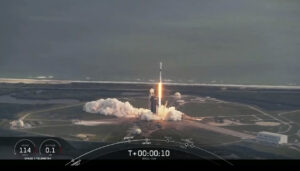Eastern from Space Launch Complex 39 at Kennedy Space Center, Florida.
Approximately eight minutes later, the Falcon 9’s first stage returned to Cape Canaveral’s Landing Zone 1, marking the company’s 70th successful recovery of a first-stage booster.
The launch was originally scheduled on Dec. 17 but was scrubbed after engineers put a hold on the countdown less than two minutes before liftoff. The company delayed the launch to evaluate a high pressure sensor reading in the upper stage liquid oxygen tank.
This was SpaceX’s second launch for the NRO. The first one was NROL-76 which flew on a Falcon 9 in May 2017 from the same pad.
The NRO builds and operates the U.S. government’s spy satellites. The NROL-108 mission and final orbit are classified. SpaceX’s webcast ended about eight minutes after liftoff and did not show the second stage.
The Falcon 9 booster used in the NROL-108 launch completed its fifth flight. It last flew on Aug. 30 when it launched the Saocom Argentine radar satellite from Cape Canaveral.
Although NROL-108 is a U.S. government mission, it was a commercially procured launch and not part of the U.S. Space Force’s National Security Space Launch program. That was also the case with NROL-76 in 2017.
The NRO and other government agencies buy commercial launch services under “delivery in orbit” contracts where the procurement of a satellite is bundled with the launch service.
Wayne Monteith, associate administrator for commercial space transportation at the Federal Aviation Administration, said the NROL-108 mission is an example of the NRO leveraging the commercial licensing process. “It’s a way to reduce costs,” he said Dec. 15 during a Space Foundation virtual event.
The NRO also has procured commercial launches from Rocket Lab, which also are licensed by the FAA.



